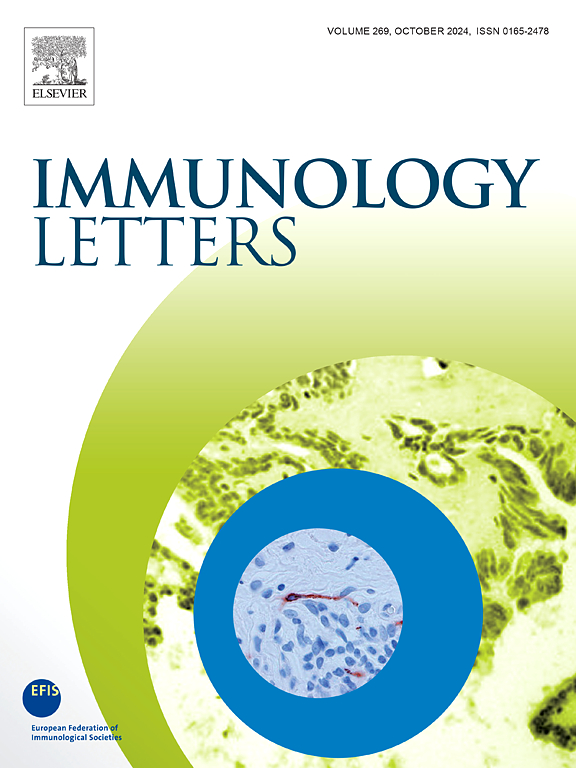Dynactin subunit 1 facilitates mast cell degranulation to drive food allergy pathogenesis
IF 2.8
4区 医学
Q3 IMMUNOLOGY
引用次数: 0
Abstract
Background
Mast cells play pivotal roles in allergic pathogenesis and inflammatory disorders, with their pathologic effects largely mediated through granule exocytosis. Dynactin subunit 1 (Dctn1), a microtubule-associated motor protein, remains unexplored in mast cell-driven inflammation. This study investigates Dctn1’s functional role in regulating mast cell degranulation during food allergy (FA).
Methods
An ovalbumin-sensitized murine FA model was established to profile mast cell activity. Gut lavage fluid (GLF) was analyzed via Olink proteomics and ELISA to quantify Dctn1 levels and mast cell mediators (histamine, Mcpt1). Mechanistic studies employed RNA interference, conditional knockout mice (Dctn1f/f Cma1-Cre), and immunoprecipitation to assess Dctn1’s role in granule trafficking.
Results
FA mice exhibited 3.2-fold higher Dctn1 levels in GLF versus controls (p < 0.001), strongly correlating with mast cell mediator concentrations (histamine: r = 0.73; Mcpt1: r = 0.7). Intestinal mast cells showed selective Dctn1 upregulation (2.8-fold mRNA increase, p < 0.01), mechanistically linked to granule trafficking through CMA1 complex formation. Mast cell-specific Dctn1 ablation reduced Mcpt1 release by 74 % (p < 0.001) and ameliorated FA symptoms (92 % core temperature drop, p < 0.005), independent of AKT/ERK signaling pathways.
Conclusions
This study identifies Dctn1 as a novel regulator of mast cell degranulation in FA, operating through microtubule-dependent granule transport. Targeted inhibition of Dctn1 significantly attenuates allergic responses without disrupting canonical activation signals, positioning it as a promising therapeutic target for mast cell-driven pathologies.
Dynactin亚单位1促进肥大细胞脱颗粒驱动食物过敏发病机制。
背景:肥大细胞在过敏性发病和炎性疾病中起关键作用,其病理作用主要通过颗粒胞吐介导。动力蛋白亚基1 (Dctn1)是一种微管相关的运动蛋白,在肥大细胞驱动的炎症中仍未被发现。本研究探讨Dctn1在食物过敏(FA)过程中调节肥大细胞脱颗粒中的功能作用。方法:建立卵清蛋白致敏小鼠FA模型,观察肥大细胞活性。通过Olink蛋白质组学和ELISA分析肠道灌洗液(GLF),定量Dctn1水平和肥大细胞介质(组胺,Mcpt1)。机制研究采用RNA干扰、条件敲除小鼠(Dctn1f/fCma1-Cre)和免疫沉淀来评估Dctn1在颗粒运输中的作用。结果:与对照组相比,FA小鼠GLF中Dctn1水平高出3.2倍(p < 0.001),与肥大细胞介质浓度密切相关(组胺:r = 0.73;Mcpt1: r = 0.7)。肠肥大细胞显示Dctn1选择性上调(mRNA增加2.8倍,p < 0.01),其机制与通过CMA1复合物形成的颗粒运输有关。肥大细胞特异性Dctn1消融使Mcpt1释放减少74% (p < 0.001),并改善FA症状(核心温度下降92%,p < 0.005),不依赖于AKT/ERK信号通路。结论:本研究确定Dctn1是FA中肥大细胞脱颗粒的一种新型调节剂,通过微管依赖的颗粒运输起作用。靶向抑制Dctn1可显著减轻过敏反应而不破坏典型激活信号,使其成为肥大细胞驱动病变的有希望的治疗靶点。
本文章由计算机程序翻译,如有差异,请以英文原文为准。
求助全文
约1分钟内获得全文
求助全文
来源期刊

Immunology letters
医学-免疫学
CiteScore
7.60
自引率
0.00%
发文量
86
审稿时长
44 days
期刊介绍:
Immunology Letters provides a vehicle for the speedy publication of experimental papers, (mini)Reviews and Letters to the Editor addressing all aspects of molecular and cellular immunology. The essential criteria for publication will be clarity, experimental soundness and novelty. Results contradictory to current accepted thinking or ideas divergent from actual dogmas will be considered for publication provided that they are based on solid experimental findings.
Preference will be given to papers of immediate importance to other investigators, either by their experimental data, new ideas or new methodology. Scientific correspondence to the Editor-in-Chief related to the published papers may also be accepted provided that they are short and scientifically relevant to the papers mentioned, in order to provide a continuing forum for discussion.
 求助内容:
求助内容: 应助结果提醒方式:
应助结果提醒方式:


